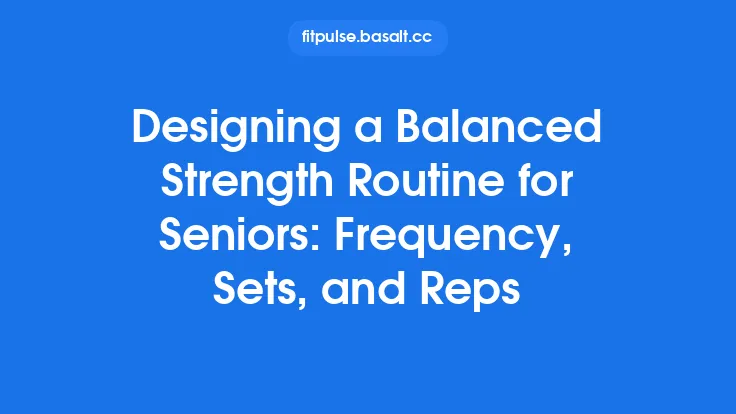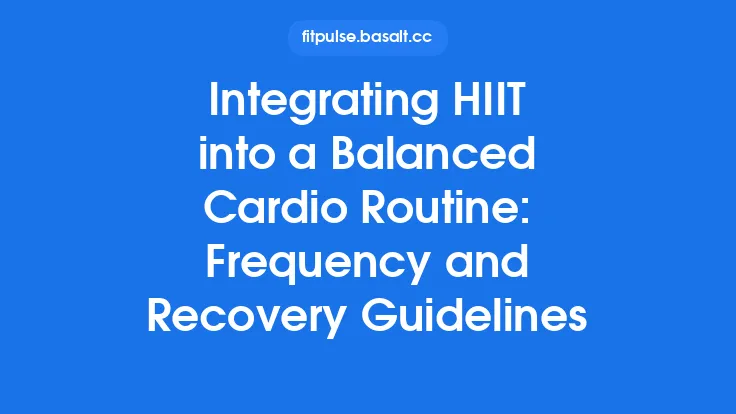Building a balanced home‑based fitness routine without any gear begins with a mindset shift: you are designing a system, not a collection of isolated exercises. The goal is to create a sustainable, adaptable program that addresses all major fitness domains—strength, endurance, mobility, and recovery—while fitting seamlessly into the rhythms of daily life. Below is a step‑by‑step framework that guides you from self‑assessment to long‑term maintenance, emphasizing the principles that keep a program effective even when the environment or personal circumstances change.
Understanding the Core Components of a Balanced Routine
A truly balanced routine touches on four pillars:
- Movement Quality – The ability to perform everyday tasks with proper alignment, joint stability, and efficient motor patterns.
- Cardiovascular Capacity – The heart’s ability to deliver oxygen to working muscles and sustain activity over time.
- Neuromuscular Resilience – The coordination between the nervous system and muscles that supports balance, agility, and reactive strength.
- Recovery Systems – Sleep, nutrition, stress regulation, and active rest that allow the body to adapt and grow stronger.
When you design a program, each pillar should receive regular attention. Ignoring any one of them creates an imbalance that can lead to plateaus, injury, or burnout.
Assessing Personal Baselines and Setting Realistic Goals
Before you write a schedule, gather data about where you stand today:
| Metric | How to Measure at Home | What It Tells You |
|---|---|---|
| Resting Heart Rate (RHR) | Take pulse first thing in the morning for 60 seconds | Cardiovascular baseline; lower RHR generally indicates better fitness |
| 3‑Minute Step Test | Use a sturdy step (≈15 cm) and a metronome set to 96 bpm; count heartbeats after the test | Aerobic capacity without a treadmill |
| Functional Movement Screen (FMS) basics | Perform a series of simple movements (squat, hinge, lunge, push‑up) and note any pain or compensation | Mobility, stability, and movement patterns |
| Perceived Exertion (RPE) during a 5‑minute brisk walk | Use the 1‑10 Borg scale | Subjective effort, useful for pacing future sessions |
| Sleep Quality | Track bedtime, wake time, and subjective restfulness for a week | Recovery capacity |
Use these numbers to set SMART goals (Specific, Measurable, Achievable, Relevant, Time‑bound). For example: “Lower my RHR from 72 bpm to 66 bpm in 12 weeks” or “Complete a 20‑minute continuous walk at an RPE of 4 within 6 weeks.” Goals anchored to measurable baselines keep progress transparent.
Structuring the Weekly Schedule: Frequency, Duration, and Distribution
A well‑rounded schedule typically follows a frequency‑duration‑intensity matrix:
| Day | Primary Focus | Approx. Time | Rationale |
|---|---|---|---|
| Monday | Movement Quality (skill work, posture drills) | 20‑30 min | Sets the tone for the week; reinforces proper mechanics |
| Tuesday | Cardiovascular Endurance (steady‑state) | 30‑45 min | Builds aerobic base without high intensity |
| Wednesday | Neuromuscular Resilience (balance, reaction drills) | 20‑30 min | Mid‑week stimulus for coordination |
| Thursday | Active Recovery (light mobility, breathing) | 15‑20 min | Facilitates adaptation, reduces soreness |
| Friday | Integrated Session (short combos of the above) | 30‑40 min | Reinforces learning, adds variety |
| Saturday | Optional Outdoor Activity (walk, hike, bike) | 45‑60 min | Encourages enjoyment and functional movement |
| Sunday | Rest or gentle stretching | — | Full recovery |
Adjust the number of sessions based on personal time constraints and recovery cues. The key is consistency—even short, regular bouts are more beneficial than occasional long sessions.
Periodization Without Equipment: Macro‑, Meso‑, and Micro‑Cycles
Periodization is the systematic variation of training variables to avoid stagnation. Even without weights, you can manipulate volume (sets × reps), tempo, rest intervals, and movement complexity across three hierarchical cycles:
- Macro‑cycle (3‑6 months) – Defines the overarching objective (e.g., “enhance aerobic efficiency while improving postural stability”).
- Mesocycle (4‑6 weeks) – Focuses on a sub‑goal (e.g., “increase walking duration at a lower RPE”).
- Microcycle (1 week) – Details the day‑to‑day plan, incorporating progressive tweaks.
Progression Strategies for an Equipment‑Free Context
| Variable | How to Progress |
|---|---|
| Volume | Add an extra set or increase repetitions by 5‑10 % each week. |
| Tempo | Slow the eccentric (lowering) phase from 2 seconds to 4 seconds, enhancing time‑under‑tension. |
| Rest | Reduce rest between sets by 10‑15 seconds to raise metabolic demand. |
| Complexity | Transition from basic patterns (e.g., static squat) to dynamic variations (e.g., squat‑to‑reach) that challenge coordination. |
By rotating emphasis—one mesocycle may prioritize volume, the next tempo—you keep the stimulus fresh while still working within the same equipment‑agnostic framework.
Manipulating Training Variables for Progressive Overload
Progressive overload is the cornerstone of adaptation. Without external loads, you rely on internal variables:
- Range of Motion (ROM): Gradually increase the depth or height of a movement. For a standing forward bend, progress from a modest flexion to a full hinge while maintaining a neutral spine.
- Unilateral Work: Performing the same movement on one side at a time forces each limb to bear the full load, effectively increasing intensity.
- Plyometric‑Style Timing (without high impact): Incorporate brief, controlled “explosive” phases—such as a rapid stand‑up from a seated position—to develop power without high‑impact jumps.
- Load Through Body Positioning: Shift the center of gravity (e.g., elevate the feet during a push‑up variation) to increase muscular demand.
- Environmental Variables: Use stairs, inclines, or uneven surfaces to add challenge without equipment.
Document these adjustments in a simple log (date, variable changed, perceived difficulty). Over weeks, you’ll see a clear trajectory of increasing challenge.
Integrating Cardiovascular Health Without Machines
Cardiovascular fitness can be cultivated through low‑impact, steady‑state activities that require no gear:
- Walking or Power‑Walking: Vary pace, incorporate intervals of brisk walking, and use natural terrain (grass, sand) for subtle resistance.
- Stair Climbing: A set of 10‑15 steps performed continuously for 5‑10 minutes raises heart rate while also engaging lower‑body musculature.
- Shadow Movement: Mimic sport‑specific motions (e.g., boxing footwork, martial‑arts stance shifts) at a moderate tempo for 10‑15 minutes.
- Dance or Rhythm‑Based Sessions: Follow a playlist and move continuously; the key is maintaining an RPE of 3‑5.
Track heart rate or RPE to ensure you stay within the aerobic zone (approximately 60‑70 % of maximum heart rate). Over time, increase duration or incorporate brief, higher‑intensity bursts (still distinct from HIIT protocols) to further challenge the system.
Prioritizing Recovery, Sleep, and Stress Management
Recovery is not an afterthought; it is an active component of the program:
- Sleep Hygiene: Aim for 7‑9 hours of uninterrupted sleep. Keep a consistent bedtime, limit screen exposure 30 minutes before sleep, and create a cool, dark environment.
- Nutrition Timing: Consume a balanced mix of protein, carbohydrates, and healthy fats within two hours post‑activity to support muscle repair and glycogen replenishment.
- Active Rest Days: Light activities such as leisurely walking, gentle stretching, or breathing exercises promote circulation without taxing the nervous system.
- Stress‑Reduction Techniques: Incorporate mindfulness, progressive muscle relaxation, or brief meditation sessions (5‑10 minutes) to lower cortisol, which can otherwise impede recovery.
Monitoring tools—sleep trackers, mood journals, or simple daily questionnaires—help you detect when recovery is insufficient and adjust training load accordingly.
Monitoring Progress and Adjusting the Plan
Objective data and subjective feedback together guide program refinement:
- Quantitative Checks (every 4‑6 weeks):
- Re‑measure RHR, step‑test results, and functional movement scores.
- Compare against baseline to quantify improvements.
- Qualitative Checks:
- Rate perceived energy levels, motivation, and joint comfort on a 1‑10 scale after each session.
- Note any recurring aches or plateaus.
- Adjustment Rules:
- If performance improves but RPE remains low, increase the difficulty of the next microcycle (e.g., add tempo work).
- If RPE spikes without performance gains, consider adding an extra recovery day or reducing volume.
- If motivation wanes, introduce a novel movement pattern or change the environment (e.g., move the workout to a balcony or garden).
A simple spreadsheet with columns for date, session focus, RPE, and notes provides a clear visual of trends and informs evidence‑based tweaks.
Creating an Optimized Home Environment
The physical space can either facilitate or hinder consistency:
- Designate a Dedicated Zone: Even a 2 × 2 meter area with a non‑slippery mat signals to the brain that it’s “work time.”
- Clear Clutter: Remove obstacles that could cause tripping or distract you.
- Lighting: Natural light boosts mood; if unavailable, use bright, cool‑white bulbs to simulate daylight.
- Ventilation: Fresh air helps regulate temperature and keeps the environment comfortable for longer sessions.
- Visual Cues: Post a simple schedule or motivational quote on the wall to reinforce habit formation.
When space is limited, consider a fold‑away setup—a mat that rolls up after each session—so the area can serve multiple household functions without permanent dedication.
Sustaining Motivation and Long‑Term Adherence
Even the most scientifically sound program falters without sustained engagement. Here are evergreen strategies that complement the structural design:
- Micro‑Goal Celebration: Acknowledge small wins (e.g., “walked 30 minutes at a steady pace”) with non‑food rewards such as a new playlist or a short leisure activity.
- Social Accountability: Share your weekly plan with a friend or join an online community focused on equipment‑agnostic fitness. Regular check‑ins create external motivation.
- Variety Cycles: Every 8‑12 weeks, rotate the primary focus (e.g., shift from “postural stability” to “cardiovascular endurance”) to keep the routine fresh.
- Reflective Journaling: Spend 5 minutes after each session noting what felt good, what was challenging, and any ideas for improvement. This habit reinforces learning and personal ownership.
- Link to Life Goals: Connect fitness milestones to broader aspirations—better energy for family activities, improved mental clarity for work, or enhanced mobility for travel. When the purpose aligns with personal values, adherence becomes intrinsic.
By embedding these psychological levers into the program’s architecture, you create a self‑reinforcing loop where progress fuels motivation, and motivation drives further progress.
In summary, a balanced home‑based fitness routine without gear is built on a foundation of clear assessment, purposeful periodization, strategic manipulation of training variables, and diligent recovery practices. Coupled with an optimized environment and robust motivation tactics, the system remains adaptable to life’s inevitable changes while delivering consistent, long‑term health benefits. Use the framework above as a living blueprint—adjust, iterate, and thrive, all without a single piece of equipment.





